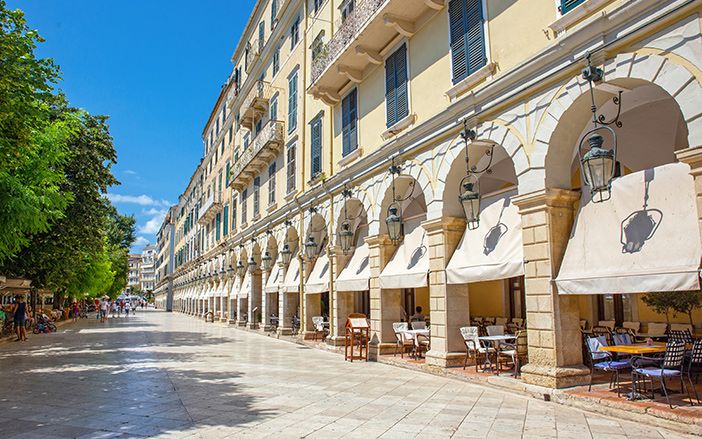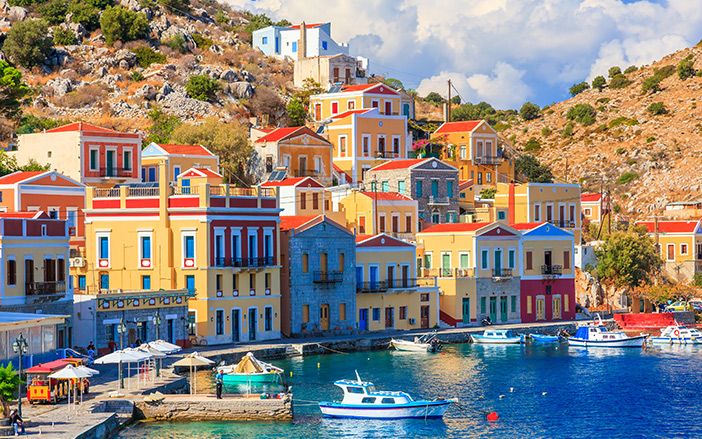Greek islands with unique architecture

It happens almost every summer: Your social media timeline gets packed
with little cubed houses in white and blue, bougainvillea, medieval arches and
colorful boats. Yes, we are talking about some of the most distinctive
elements of architecture found on the Greek islands, captivating their
visitors. The history of each region, as it is written in the books, but also
as narrated by the inhabitants, pirate attacks, years and years of foreign
occupation, they have all placed a little stone on the creation of what we now
know and love about the islands, and most of the times recognize instantly
from just one image, like the village of Klima in Milos. Some have also been a
great source of inspiration for great artists of architecture such as the
famous Le Corbusier who fell in love with the crisp cubism of Mykonos many
years ago.
On your next trip, try to acknowledge all the elements
that make the Greek islands become an example of architecture and find their
place in special features of international design magazines. Compare
prices, find the route that suits you and book
cheap ferry tickets through Let’s Ferry.
Ios, Naxos, Tzia: Homes built over cobblestones
Ios,
Naxos
and
Tzia
have one thing in common: Many of the islands’ houses, instead of extending
upwards, continue their floorplans over the cobbled streets. This extension
looks like an arch over the street, and it is called "sheltered" or "stigadi".
This invention started mainly due to the lack of space and you will only find
it in very narrow alleys. One village that is completely covered with stigadia
is Koronos in Naxos, while the other two islands feature the same feature
scattered around their Choras. Such constructions were a last resort for poor
families, but today they make up for a beautiful scenery, adorned with
jasmine, evening primrose or bougainvillea.
 Traditional cobblestone
Traditional cobblestone
Corfu: With the essence of Venice
The four decades that the Venetian rule lasted influenced the
architecture, dialect and culture of the Ionian islands. One of the most
characteristic examples is the island of Phaeacians that the Venetians
occupied from 1386 to 1797. It was then that the green Spianada Square
expanded and nestled in its current shape but also when the New Fortress was
built on the hill of Agios Markos. Drawings of the era show that the Old Town
of
Corfu
has remained almost unchanged over time. With less of a Byzantine and more of
a medieval style, the buildings in the historic center are high, built next to
each other, with elaborate details.
 Historical center of Corfu
Historical center of Corfu
Milos: The island with the "wires"
The volcanic island of the Cyclades with its incredible beaches, has
one thing in common with its sophisticated neighbor,
Kimolos: The wires. We are not talking about metal ones, but the famous colored
houses on the sea. They usually belong to fishermen and their most distinct
feature is their big, wide doors that each winter keep the boats dry until
next summer. Many locals choose to rent these houses in the summer, to
tourists who want to live a more traditional experience. In
Milos, you will find such colorful houses in Klima and Firopotamos, while the best
place for Wires is Kimolos is Goupa.
 Klima in Milos
Klima in Milos
Rhodes: Casually medieval style
Although you will come across many influences from the Ottoman and
Byzantine empires on the island, the one that actually prevails is the
architecture of the Renaissance. The presence of the Order of the Knights in
the 14th century played a big role in this. It is no coincidence that the Old
Town of
Rhodes, with its stone cobbled streets and Gothic towers, is one of the most
well-preserved ones in Europe. It has been protected as a World Heritage Site
by UNESCO since 1989. Excellent examples of the style are the Palace of the
Grand Master, the Knights Street and the Knights' Hospital.
.jpg) Palace of the Grand Master in Rhodes
Palace of the Grand Master in Rhodes
Symi: Neoclassical color palette
Since 1971, the tiny Dodecanese island has been designated as a
protected settlement. The colorful captain's houses are the first ones you
will bump into as soon as you arrive at the port of
Symi, in the settlement of Gialos. The houses are 2 or 3 floors high and among
their common elements are the roof, the pebbled courtyards with mosaics, the
whitewashed gables, the colored windows and the triangular tiled roofs. Colors
such as lilac, brown and ocher give the buildings their neoclassical
character.
 The colorful captain's houses in Symi island
The colorful captain's houses in Symi island
Santorini: The cave kingdom
Volcanic, mysterious, cosmic, vibrant, inexhaustible. The cave houses
of the island are one of the elements that make it stand out, each time you
visit. Many have recently turned into luxury accommodations but originally,
they were homes for the poor island inhabitants. We are basically talking
about houses that look like caves and domes, built inside and protected by the
earth. These homes are very resilient when it comes to earthquakes and extreme
temperatures. The living room and the bedrooms were built under the earth,
while the kitchen and the toilet were placed in separate rooms, outside the
house. At the edge of the Caldera, in Fira and Oia, you will find some of the
best ones. Choose to stay in a cave house next time you book cheap
ferry tickets to Santorini
via Let’s Ferry.
 White houses in Santorini island
White houses in Santorini island
Chios: The village with the sculpted facades
A unique spectacle awaits you on the delicious island of the
Dodecanese. In the village of Pyrgi, the houses have engraved facades,
creating unique, black and white geometric shapes. This medieval technique is
said to have been imported from Italy and the whole "painted village", as it
is widely known, has been declared a protected area. You will find this
technique in houses, arches, churches, under balconies, in public services and
in shops. The village is 25 km from the port of
Chios
and you can reach it by car or bus.
.jpg) Traditional houses in Chios
Traditional houses in Chios
Walking around on the island cobblestones is one of the best pastimes
when you visit them. Loose your gaze on architectural environments that look
like they are pages torn out from a book and recognize the unique architecture
of each place. But first, explore each destination and book cheap ferry
tickets online with Let’s Ferry.